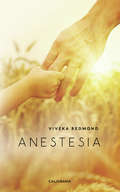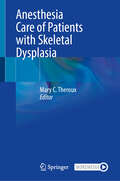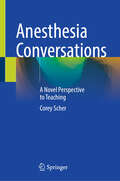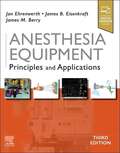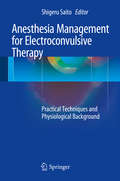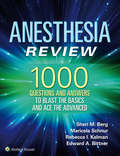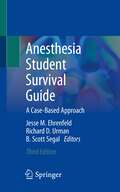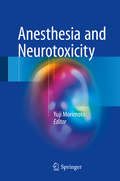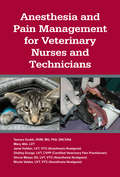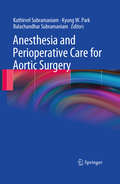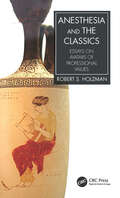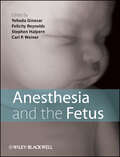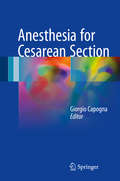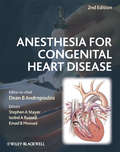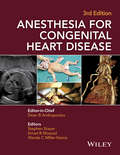- Table View
- List View
Anestesia
by Viveka RedmondTendría mucho que decirte, pero no quiero hacerlo con tinta y pluma. Espero verte pronto y hablar cara a cara. Anestesiarnos. Quedarnos dormidos hasta que la herida se haya cerrado por completo. Hasta que deje de doler. Y si lo aplicamos al cuerpo, ¿cómo no tratar de hacer lo propio con el alma cuando la vida nos pone a prueba? Colocamos parches encima de cada roto. Hacemos remiendos con agujas sin hilo. Cualquier alternativa antes que encarar nuestra debilidad. Antes que mirarla a los ojos. Anestesia es un canto a la esperanza frente a las dificultades, entonado en clave de amor verdadero. Ese que pasamos toda la vida buscando. Ese que nos da fuerza. El que lleva la paz a la confusión. El que da sentido a todo. A pesar de todo. Un viaje a través de los sentimientos fundamentado sobre la fuerza del perdón, que refleja determinadas alternativas con las que, en ocasiones, tratamos de enfrentar e incluso evitarel sufrimiento.
Anesthesia Care of Patients with Skeletal Dysplasia
by Mary C. TherouxPatients with skeletal dysplasia are at greater risk for adverse events, including death, during or shortly after their anesthetic care. Due to advancements in medical and surgical treatment modalities, patients with skeletal dysplasia now enjoy a longer life span, emphasizing the importance of broader awareness and deeper understanding of the specialized anesthetic management required to ensure their safety and successful outcomes. This book provides a comprehensive overview of anesthetic care and management tailored specifically towards various forms of skeletal dysplasia. The chapters are organized into sections that focus on the different forms of skeletal dysplasia and their associated co-morbidities. They provide insights on how to anticipate and manage potential complications that may occur during the anesthetic care of these complex medical patients. Additionally, the book highlights the patient&’s perspective, shedding light on the challenges individuals with skeletal dysplasia encounter in accessing appropriate anesthesia care. Intended primarily for practitioners of anesthesia, sedation, and critical care, this publication also serves as a resource for individuals with skeletal dysplasia who require anesthesia care. An understanding of the anesthesia process by the patients and families enables them to choose optimal care for a successful outcome.
Anesthesia Complications in the Dental Office
by Stuart Lieblich Robert BosackAnesthetic complications, which range from simple annoyances to patient mortality, are inevitable, given the many and complex interactions of doctor, patient, personnel, and facility. Anesthesia Complications in the Dental Office helps dentists minimize the frequency and severity of adverse events by providing concise and clinically relevant information that can be put to everyday use. Anesthesia Complications in the Dental Office presents the most up-to-date information on treating anesthesia complications and medical emergencies. Drs. Bosack and Lieblich and a team of expert contributors discuss patient risk assessment; considerations for special needs and medically compromised patients; routinely administered anesthetic agents; adversities that can arise before, during, and after administration of anesthesia; and emergency drugs and equipment. A must-have reference for every dental office.
Anesthesia Conversations: A Novel Perspective to Teaching
by Corey ScherThis book presents a variety of challenging anesthesia cases that are based on the author's extensive clinical experience and his ongoing mission to learn. The premise is the rebuilding of the department of anesthesiology in post-hurricane Katrina, New Orleans. The structure of the book follows a unique fictional format that reads more like a fictional mystery novel with complex anesthesia cases embedded in the fictional story. The book's goal is to increase the reader's memory of the basic fundamentals of case management in this unique format.
Anesthesia Equipment: Principles And Applications
by James B. Eisenkraft Jan Ehrenwerth James M. BerryOffering highly visual, easy-to-read coverage of the full range of anesthesia equipment in use today, this authoritative reference is your go-to text for objective, informed answers to ensure optimal patient safety. Anesthesia Equipment, 3rd Edition, provides detailed information on the intricate workings of each device or workstation, keeping you fully up to date and helping you meet both equipment and patient care challenges.
Anesthesia Management for Electroconvulsive Therapy: Practical Techniques and Physiological Background
by Shigeru SaitoIn this book, recognized anesthesiology experts present the latest findings on anesthesia for electro-convulsive therapy (ECT). With the development of modified electroconvulsive therapy (m-ECT) and devices to provide brief-pulse stimulation, ECT is currently being re-evaluated as an important procedure in psychiatric disorder therapy and is increasingly being used worldwide to treat several psychiatric conditions. This trend is due to the social phenomenon of the growing number of patients for whom ECT is applicable. Since the new approach is more safe and effective than the original method without anesthesia, m-ECT is currently applied under general anesthesia in most advanced countries. This book provides an overview and practice of total anesthesia management in the perioperative period of ECT. It offers an indispensable resource not only for professional anesthesiologists but also healthcare professionals who use this therapy.
Anesthesia Oral Board Review
by Jessica A. Lovich-SapolaThe 101 entries in this exam preparation guide are arranged in 18 sections on monitors and machines, electrolyte abnormalities, airway management, and surgical specialties. Each entry opens with a sample case, reviews clinical issues, and outlines a treatment plan for answering questions during an actual oral exam. The editor teaches at Case Western Reserve School of Medicine and most of the contributors are anesthesiologists at MetroHealth Medical Center in Cleveland. Annotation ©2011 Book News, Inc. , Portland, OR (booknews. com)
Anesthesia Oral Board Review: Knocking Out The Boards
by Lovich-Sapola, Jessica A.A fully updated edition of a popular, illustrated review book, covering all of the essential topics required to pass the current American Board of Anesthesiology Applied Oral and OSCE Examinations. Thoroughly revised to reflect recent literature and changes in anesthesia practice, 12 new chapters explore topics like Point of Care Ultrasound (POCUS), Intraoperative Transesophageal Echocardiography (TEE), Foreign Body Aspiration, and Patient Blood Management. The book also contains questions and model answers, alongside valuable tips for exam success reflecting the new exam structure. Chapters feature a sample case and clinical issues alongside a Knockout Treatment Plan, a model providing an answer that could be used in the exam, and a Technical Knockout section, offering additional tips for successfully passing the examination. An evidence-based approach presented in a concise outline-oriented format, this resource also functions as an introduction to anesthesia rotations and as a technical study guide for students.
Anesthesia Review: Blasting The Boards
by Sheri BergWith contributors from Massachusetts General Hospital and Harvard Medical School, the unique and thorough Anesthesia Review: 1000 Questions and Answers to Blast the BASICS and Ace the ADVANCED covers both BASIC or ADVANCED levels of Anesthesiology training in a single volume. Any resident in Anesthesiology will find a gold mine of material—including topic-specific chapters with exam-like questions, answers with explanations, and references for further, in-depth review—for fast, efficient preparation.
Anesthesia STAT! Acute Pediatric Emergencies in PACU: A Clinical Casebook
by Susan T. VergheseThis case-based book comprehensively covers the clinically significant problems that can occur in children in the immediate postoperative period after surgery after admission to Post Anesthesia Care Unit. Chapter authors first focus on how clinical monitoring and safety of post-op patients can and must continue after hand off to the PACU team and then describe 24 interesting clinical scenarios that needed urgent intervention in PACU. The goal of this book is to teach members of the perioperative teams around the globe how to keep anesthesia stat calls to a minimum. Anesthesia STAT! Acute Pediatric Emergencies in PACU features contributions from leaders in pediatric anesthesiology and be an indispensable guide for the perioperative and postoperative team in preventing potential problems during the post-anesthetic period.
Anesthesia Student Survival Guide: A Case-Based Approach
by Richard D. Urman B. Scott Segal Jesse M. EhrenfeldThis comprehensive update of the previous two successful editions covers both basic and advanced anesthesia topics. These include pharmacology, procedures, monitoring, equipment, subspecialty anesthesia, safety, professionalism, pain management, and more.Chapters are concise, easy-to-read, and authored by faculty specialized in medical education. They feature case studies designed to help apply theoretical knowledge to real patient situations, as well as questions and answers. A convenient resource for medical students, student registered nurse anesthetists, and student anesthesiologist assistants in any student of anesthesia will find this unique book useful.
Anesthesia Student Survival Guide: A Case-Based Approach (Lecture Notes In Biomathematics #Vol. 30)
by Richard D. Urman Scott Segal Jesse M. EhrenfeldAnesthesia Student Survival Guide: A Case-Based Approach is an indispensable introduction to the specialty. This concise, easy-to-read, affordable handbook is ideal for medical students, nursing students, and others during the anesthesia rotation. Written in a structured prose format and supplemented with many diagrams, tables, and algorithms, this pocket-sized guide contains essential material covered on the USMLE II-III and other licensing exams. The editors, who are academic faculty at Harvard Medical School, summarize the essential content with 32 informative and compelling case studies designed to help students apply new concepts to real situations. Pharmacology, basic skills, common procedures and anesthesia subspecialties are covered, too, with just the right amount of detail for an introductory text. The unique book also offers a section containing career advice and insider tips on how to receive good evaluations from supervising physicians. With its combination of astute clinical instruction, basic science explanation, and practical tips from physicians that have been there before, this handbook is your one-stop guide to a successful anesthesia rotation.
Anesthesia and Analgesia for Veterinary Technicians (Fourth Edition)
by John A. Thomas Phillip LercheHandbook for veterinary doctors and technicians to administer anaesthesia in terms of preparation of patient, induction procedures, monitoring vital signs during the anaesthetic period and postoperative care.
Anesthesia and Analgesia for Veterinary Technicians and Nurses
by John A. Thomas Phillip LercheMaster the veterinary technician’s role as a veterinary anesthetist! Covering the principles of animal anesthesia and pain management, Anesthesia and Analgesia for Veterinary Technicians and Nurses, 6th Edition is the definitive guide to the latest drugs, techniques and protocols, and anesthetic equipment. Clear guidelines to anesthesia administration include pre-anesthetic preparation of the patient, induction procedures, the monitoring of patients’ vital signs during the anesthetic period, and postoperative care. Written by expert educators John A. Thomas and Philip Lerche, this trusted text prepares you for success in the classroom and on the Veterinary Technician National Exam (VTNE).
Anesthesia and Analgesia in Dermatologic Surgery (Basic And Clinical Dermatology Ser. #42)
by Marwali Harahap Adel R. AbadirWith malpractice insurance premiums on the rise, and insurance rates for the practicing anesthesiologist at an all time high, it is important, now more than ever, to have a single source reference related to both anesthesia and analgesia and how they both relate to dermatologic surgery. This book provides comprehensive coverage on the therapeutic u
Anesthesia and Neurotoxicity
by Yuji MorimotoThis book, written by leading Japanese experts in the field, describes the latest findings on the neurotoxicity of anesthetics for the developing brain, postoperative delirium and cognitive dysfunction. It describes the risk factors for postoperative cognitive dysfunction in elderly surgical patients. Since the number of elderly patients undergoing surgery and anesthesia continues to increase, it is important to improve our understanding of the risks and mechanisms of postoperative delirium and cognitive dysfunction, potential ways to prevent or alleviate them and the public health implications. Recently, it has been shown that using anesthetics on the developing brain causes apoptotic neurodegeneration and persistent learning/memory deficits later in life. Anesthesiologists need more information on this mechanism in the human brain. The negative effects of anesthesia and surgery on the nervous system have attracted attention lately; this book provides physicians, researchers, and postdocs with invaluable information on this topic.
Anesthesia and Pain Management for Veterinary Nurses and Technicians
by Mary Albi Janel Holden Shelley Ensign Shona Meyer Nicole Valdez Tamara L. GrubbThis textbook and clinical guide is ideal for veterinary nurses and technicians in training. It offers a concise yet comprehensive resource for veterinary students and practitioners desiring a review of anesthesia and analgesia with step-by-step guidelines. A wealth of illustrations illustrate the theory in practice.
Anesthesia and Perioperative Care for Aortic Surgery
by Balachundhar Subramaniam Kathirvel Subramaniam Kyung W. ParkThis book is the first of its kind - a comprehensive reference for anesthesia and perioperative clinicians involved in aortic surgery. With a primary focus on anesthesia for various aortic surgical procedures, including endovascular aortic surgery, the title also provides expanded coverage of CNS monitoring and protection, intraoperative transesophageal echocardiography, renal and spinal cord protection during surgery, management of aortic trauma, and postoperative care. Written by top cardiac anesthesiologists, surgeons, and intensivists, this indispensable reference provides everything you need to know about the burgeoning field of aortic surgery in one handy volume.
Anesthesia and Perioperative Care for Organ Transplantation
by Kathirvel Subramaniam Tetsuro SakaiThis comprehensive textbook, covering all aspects of the perioperative management of patients undergoing organ transplantation, serves as the standard reference for clinicians who care for transplant patients on a day-to-day basis as well as those who encounter organ transplantation only occasionally in their clinical practice. Anesthesia and Perioperative Care for Organ Transplantation covers transplantation of the heart, lung, liver, pancreas, and kidney, as well as multivisceral and composite tissue graft transplantations. For each kind of transplantation, the full spectrum of perioperative considerations is addressed: preoperative preparation, intraoperative anesthesia management, surgical techniques, and postoperative care. Each chapter contains evidence-based recommendations, relevant society guidelines, management algorithms, and institutional protocols as tables, flow diagrams, and figures. Photographs demonstrating surgical techniques, anesthesia procedures, and perfusion management are included. Anesthesia and Perioperative Care for Organ Transplantation is for anesthesiologists and critical care physicians; transplantation surgeons; nurse anesthetists; ICU nurses; and trainees.
Anesthesia and Perioperative Care of the High-Risk Patient
by Ian McConachie MB ChB FRCA FRCPCThe fully updated third edition of this popular handbook provides a concise summary of perioperative management of high-risk surgical patients. Written by an international group of senior clinicians, chapters retain the practical nature of previous editions, with concise text in a bulleted format offering rapid access to key facts and advice. Several new chapters cover topics including: anesthetic mortality; cardiopulmonary exercise testing; perioperative optimization; obstructive sleep apnea and obesity hypoventilation syndrome; smoking, alcohol and recreational drug abuse; intraoperative ventilatory management; the role of simulation in managing the high-risk patient; anesthesia, surgery and palliative care; anesthesia and cancer surgery; neurotrauma and other high-risk neuro cases; anesthesia for end-stage renal and liver disease; and transplant patients. Essential reading for trainee anesthesiologists managing seriously ill patients during surgery or studying for postgraduate examinations, this is also a valuable refresher for anesthesiologists and intensivists looking for an update on the latest evidence-based care.
Anesthesia and the Classics: Essays on avatars of professional values
by Robert S. HolzmanA collection of 25 thought provoking Essays which create a bridge between the Classical personification of values and link them to current training and education in Western Medicine. This readable and erudite text provides a framework for modern clinical values - with a particular emphasis on anesthesiology - set in the context of ageless dilemmas facing each generation of physicians. Medicine as a profession carries some specific obligations.The qualities of empathy, knowledge, generosity, respect, and scholarship provide a "family" of values that was personified by the Ancients in the family of Asklepios, and which form the basis of professional values today. Moreover, a substantial amount of professional growth should come from reflection based on the experience of caring for real patients – an appreciation of the human condition. Each essay within this beautifully crafted book illustrates the importance of expertise, skill, focus, mindfulness, and collaboration, all of which are integral to professionalism in medicine, and in particular to those working in the field of anesthesiology. Anesthesiologists, Certified Registered Nurse Anesthetists and Anesthesia Assistants will find much to enhance their professional understanding within this text. The principles, values and traits of professionalism are relevant to all medical specialties and these essays provide a lyrical understanding of the traits required for professional development.
Anesthesia and the Fetus
by Stephen H. Halpern Felicity Reynolds Carl Weiner Yehuda GinosarAnesthesia and the Fetus integrates into one volume the multidisciplinary components of:fetal developmentfetal pharmacologyassessments of fetal and neonatal outcomeanesthesia and analgesia during pregnancyanesthesia and analgesia during laborethics and lawWritten by an internationally renowned group of clinicians and scientists, Anesthesia and the Fetus provides a contemporary guide and reference to the role of anesthesia, and the anesthesiologist, in protecting the mother and her unborn child during pregnancy.
Anesthesia for Cesarean Section
by Giorgio CapognaThis book examines every aspect of anesthesia in patients undergoing cesarean section. Anesthetic and surgical techniques are clearly described, with detailed guidance on indications and contraindications and identification of potential complications. Practical information is provided on postoperative analgesia, postoperative course and nursing, the significance of cesarean section for breastfeeding, and the occurrence of long-term problems and chronic pain after cesarean section. Other topics to be addressed include the history and epidemiology of cesarean delivery, effects on the fetus and neonate, ethical issues, the humanization of childbirth, and maternal expectations and satisfaction. While many books are available on obstetric anesthesia, none is exclusively devoted to cesarean section although it is one of the most frequently performed surgeries. Anesthesia for Cesarean Section will be appreciated by all anesthesiologists and will be a useful source of information for obstetricians, gynecologists, midwives, nurses, medical students, and trainees.
Anesthesia for Congenital Heart Disease
by Dean B. Andropoulos Emad B. Mossad Stephen A. Stayer Isobel A. RussellThis timely revision reflects the rapid advances in surgery and anesthesia for congenital heart disease that have occurred in recent years, including neonatal cardiac surgery and anesthesia, treatment of single ventricle patients, new diagnostic modalities, and developments in the catheterization laboratory. New chapters address mechanical support of the circulation, embryology, and quality/outcomes management.
Anesthesia for Congenital Heart Disease
by Dean B. Andropoulos Emad B. Mossad Stephen A. Stayer Wanda C. Miller-HanceThe third edition of Anesthesia for Congenital Heart Disease, the recognized gold-standard reference in this field, offers a major update and expansion of the textbook to reflect the ongoing development of the practice of pediatric and congenital cardiac anesthesia and the burgeoning knowledge base in this exciting field. Includes two new chapters addressing key areas; anesthetic and sedative neurotoxicity in the patient with congenital heart disease, and anesthesia in the patient with pulmonary hypertension Now in full color, with over 200 illustrations and photographs Multiple-choice questions accompany each chapter covering the most crucial learning points to optimize the learning experience for readers at all levels
